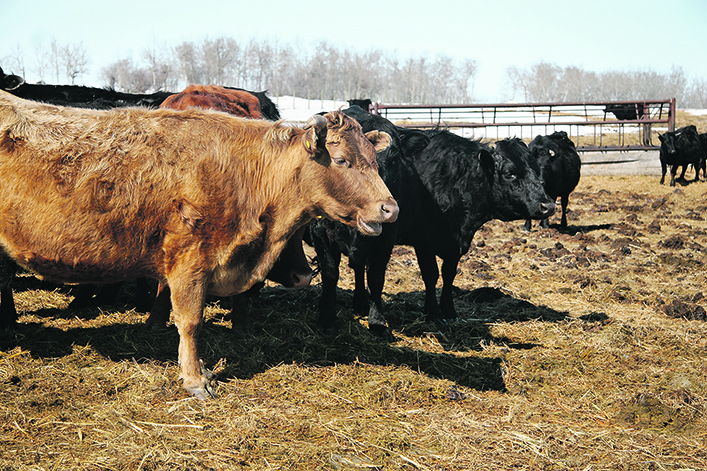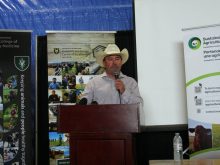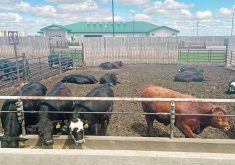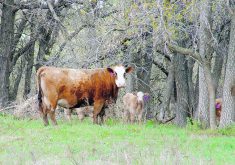Farmers must balance waste-not, want-not approach with proper prep and take specific steps before and while grazing
Glacier FarmMedia – Corn stover isn’t a common feed source in Western Canada, but a study suggests there’s potential for cattle if it’s managed correctly.
In the study, bred cows were fed high-moisture corn residue or stover in an extended winter grazing system.
“In drought years, corn stover can be less expensive to feed than barley greenfeed, but will require more supplementation to ensure cow productivity is not compromised,” says a summary of the project published by the Beef Cattle Research Council, which funded the study.
Read Also

Tick research from the University of Manitoba focuses on insects and testing
Manitoba researchers are looking into the effects of tick and fly disease in cattle.
A lot of preparation goes into any successful extended grazing program, especially if it involves a new forage source, noted University of Saskatchewan researcher Bart Lardner, who worked on the project at the university’s Livestock and Forage Centre of Excellence.
“Whether it’s cereal residues or high-moisture corn stover, realize there’s two things you have to think of,” he said.
The first is to be prepared for windy and wintery conditions. Residue from corn stover, which is harvested at 30 per cent moisture, has to be managed for winter grazing.
“Some of the challenges were, how do we preserve it, how do we manage it when we have cattle out there?” Lardner said.
“If you just leave it on the ground in a windrow, with snow and the winter conditions, it’s challenging for the animals to get to it. It’s different than a swathed whole plant cereal.”
Researchers decided to bale the stover.
“Even doing that — putting it into big square bales — there was some challenges because of the higher moisture and the freezing. So that obviously affected palatability and intake of the residue.”
The second issue was nutrition. Lardner stressed the need to test the stover.
“You need to know the nutritive value density of it going into the winter feeding program. You need to know the energy and protein value of it and, obviously, you also need to know the requirements of those cows if they’re in a second trimester pregnancy or first or whatever.”
As in most extended grazing options, wildlife are an issue. Feed left in the field is easy pickings for deer.
Corn stover advocates made a pitch for its feed potential in 2021, at the height of Manitoba’s drought. Corn stover provides feed biomass when other forage may be thin, argued Alfred Billingham of Argyle. He had used stover for years to round out feed rations.
On the downside, harvest could be hard on normal equipment, and Manitoba’s short harvest window and typical fall conditions raised worries about moisture and spoilage.
Success of a new feeding program is always measured by cow condition. Cows should be at three on the five-point body condition score scale, Lardner noted, giving them adequate fat reserves without being obese. They should maintain that number through the winter and into calving.
The BCRC says cows with that ideal score rebreed up to 30 days quicker than underconditioned cows, which are any animal with a score of two or lower. They conceive more easily, have healthier calves, produce more milk and their calves can be up to 42 pounds heavier at weaning.
“Thin cows don’t rebreed, and that’s obviously what you need to keep in mind,” Lardner said.
No crop residue will totally meet a cow’s needs, he cautioned, “so you have to step in with some type of a supplementation program.”

Dried distillers grains or cereal grain are among those supplement options.
Crop residue grazing in the open field comes with its own challenges, among them wind and cold. Manitoba Agriculture warns that a cow with a body condition score of one or two will have to burn more calories to stay warm at a higher temperature than a better conditioned cow.
The point where an animal has to increase its metabolic rate to stay warm is -17 C for thin cows and -25 C for those with a body condition score of three.
Project researchers also did a rib and rump ultrasound on the cows, a method Lardner recommends for anyone starting a new grazing system. This test correlates with body condition scores.
Lardner’s biggest recommendation, however, is to ease into any experiment with extended winter grazing.
“Do your research. Start small,” he said. “Don’t go and grow a whole quarter section full of corn and take it off as high-moisture corn stover and then Mother Nature says, ‘no, you’re not going to graze it,’ and you don’t have Plan B in your back pocket.
“Try 20, 30 acres. Have a Plan B, which is bringing them back to the yard and feeding them round bales with a round bale feeder or maybe swath grazing or maybe bale grazing. Spread your risk.”
The corn stover study was one part of a bigger industry effort to test a range of residues for grazing potential.


















